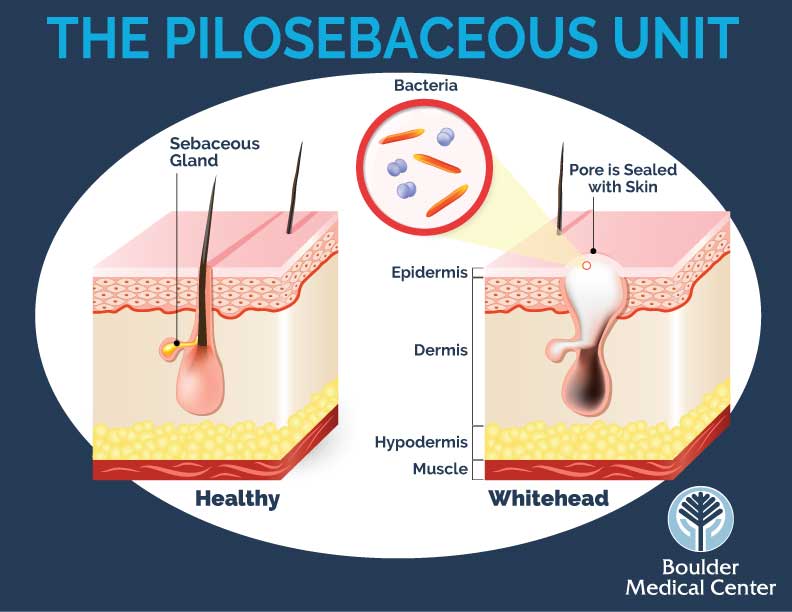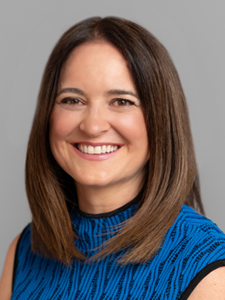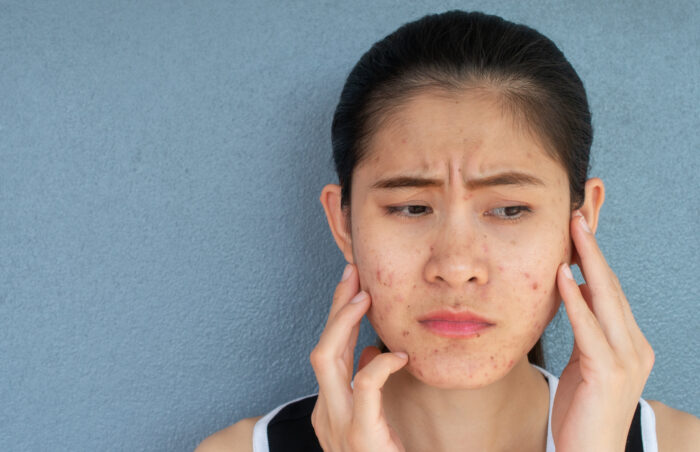Teen Acne Survival Kit: A Guide for Clearer Skin
by Chesney Kennedy, MD
Pediatrics at Boulder Medical Center
Longmont and Boulder
You are one of the rare lucky ones if you have never had acne. Acne affects 90% of teenagers and usually starts between ages 10 and 13. It is worse in the teenage years but can extend to age 30! Many preteens or teens don’t think to bring the subject up with their parents or doctor, thinking they have to live with acne and suffer through it. This is not true.
There are many excellent acne treatments. We all know that acne can be depressing and can cause permanent scars on the face, chest, and back. We feel better emotionally when our complexions are clearer. Acne treatments can clear our complexions, prevent scars, and give us a skip in our steps.
First, a few notes:
- Note #1: For this article, I use the words “male” and “female” to relate to the sex one is assigned at birth (or the physical traits your child was born with). In addition, gender identity matters when it comes to acne treatment. Your doctor needs to know your child’s gender identity to prescribe the best treatment.
- Note #2: Although I mention many products and medications in this article, I receive zero funding from them and have no financial incentives.
- Note #3: The information provided in this blog is for general informational purposes only and is not intended as a substitute for professional medical advice, diagnosis, or treatment. Always seek the advice of your physician or other qualified health provider regarding a medical condition. Never disregard or delay seeking professional medical advice because of something you have read on this blog. If you think you may have a medical emergency, call 911 immediately.
*****
 What Causes Acne?
What Causes Acne?
To understand acne, we need to start with the basics: the pore, also known as the pilosebaceous unit. Acne forms when three key factors come into play — hormones, sluggish skin cell turnover, and bacteria.
Hormones
At the bottom of the pilosebaceous unit is a gland controlled by hormones. The gland produces sebum – the oily substance that collects in your pores to form acne. Hormones can cause overproduction of sebum. One of these hormones is testosterone, typically considered the male hormone, but females make some testosterone, too. Stress can cause testosterone levels to increase, which is why stress makes your acne worse. The other hormone that affects acne is progesterone. Females get a surge of progesterone before their period starts. This explains why acne often gets worse right before a period. Many acne treatments target hormones.
Inefficient Skin Cell Turnover
This condition can cause dead skin cells to create a keratin plug in the pilosebaceous unit. It helps to imagine a blocked oil well. The oil can’t reach the skin’s surface, so it accumulates deep in the pilosebaceous unit and can form whiteheads. Or, oil can build up pressure and explode like a volcano. If the plug explodes down deep, cysts can form. If it pops toward the top, you get a pus-filled bump on the skin’s surface (the classic pimple). A blackhead is created when the oil comes to the surface and oxidizes, causing the color to darken. Over-the-counter pore strips will remove a blackhead’s dark color for a couple of days, but the oil re-oxidizes, so this is not a great long-term solution (but it might be handy before prom). Many acne medications work by increasing skin cell turnover to prevent plugs from forming in the first place.
Bacteria: The bacteria called Propionibacterium acnes (P. acnes) that we all have on our skin contributes to acne formation, and many acne treatments target this bacteria.
Can Foods Cause Acne?
There used to be a myth that overeating chocolate caused acne, but a classic study from 1969 in the Journal of American Medical Association showed this is probably not the case. However, the study group only ate one chocolate bar per day, and diets were healthier in 1969. Now, we have newer studies that show high glycemic diets and diets high in sugar make acne worse. We think this is because sugar can cause more inflammation in the body. So limit sugar intake and eat plenty of fruits and vegetables, healthy proteins, and slow-burning carbohydrates like beans, lentils, quinoa, brown rice, whole grains, or sweet potatoes.
Skin Care 101 for Teens With or Without Acne
- Morning
- Step 1 — Cleanse. When you enter a drug store aisle, you will see many facial cleansers targeting acne. These products may have benzoyl peroxide or salicylic acid. Unfortunately, these skin cleansers only stay on your face for about 5 seconds before rinsing and will not do much to help your skin. Instead, I recommend a gentle skin cleanser like Cerave, Cetaphil liquid cleansers, or Dove soap with no fragrance. If your face is not too oily in the morning, using a cleanser may be unnecessary. You can splash your face with water to wake up.
- Step 2 — Possibly use acne medication, depending on your regimen.
- Step 3 — Moisturize if your skin is dry. Although everyone has different skin conditions, skin is typically quite oily during our teens, and we may not need a moisturizer. However, some acne medicines can make your skin dry. Or maybe you live in a dry climate (like we do in Colorado) and need extra moisture. You may need to experiment. I recommend a non-comedogenic moisturizer, meaning the product will not clog your pores. Here are some non-comedogenic moisturizers:
- Cerave PM Facial Moisturizing Lotion
- Cerave Moisturizing Cream
- Cerave Ultralight moisturizing Face Gel
- Cetaphil Moisturizing Cream
- Paula’s Choice Clear Oil Free Moisturizer
- Other: If you want to try something natural, a few drops of hempseed or argan oil are considered non-comedogenic.
- Step 4 — Apply sunscreen (at least SPF 30). The earlier you start using a daily face sunscreen, the better. It prevents skin cancer, wrinkles, and dark spots later in life. In addition, most acne medications make your skin more sensitive to the sun, so sunscreen is essential. A zinc-based, non-comedogenic sunscreen is ideal for teens with acne. Zinc is safer for our bodies and the environment. Ideas for products are:
- Cerave Hydrating Mineral Sunscreen SPF 30 Sheer Tint
- Cerave Hydrating Mineral Sunscreen for Face SPF 50
- Cetaphil Sun 30 Sheer Mineral Sunscreen
- Cetaphil Sun 50 Sheer Mineral Sunscreen
- Differin oil-absorbing moisturizer
- Eucerin Sensitive Tinted Mineral Face Sunscreen SPF 35
- Tower 28 SPF 30: comes in lots of different tints and excellent natural ingredients
- Neutrogena Sheer Zinc Face SPF 50
- SkinCeuticals Physical Fusion UV Defense SPF 50 Mineral Sunscreen
- Evening
- Step 1 — Cleanse
- Step 2 — Acne medication, depending on your regimen
- Step 3 — Moisturize if your skin is dry
The Basics of Acne Treatment
Acne creams or gels are designed to prevent future pimples. It is important to note that these products will not improve the pimples that you currently have. However, consistently and regularly using these products can help prevent breakouts. It is ineffective to only apply the cream or gel on individual pimples; the product should be applied to your entire face every time for best results.
Sadly, there is no instant gratification with any acne treatment. Most treatments take 2-3 months to work. Be patient—it is worth it!
However, if it doesn’t work, talk to your doctor about trying something stronger or different.
Treating Mild Acne
Benzoyl Peroxide — If you have just a few pimples or blackheads, you can start with over-the-counter benzoyl peroxide (2.5%, 5%, or 10%) once daily, morning or night. Although these products have three strengths, they work about the same. Benzoyl peroxide comes in creams and gels. Gels are better for very oily skin, and creams are better for dryer skin. I love benzoyl peroxide because not only does it break down dead skin cells, but it also has a natural antibiotic effect against P. acnes bacteria. Don’t forget that benzoyl peroxide can bleach your clothes or sheets, so be careful when applying. I recommend using white sheets and wearing white pajamas. If your skin becomes too dry with benzoyl peroxide, you can use it every other night until your skin gets used to it. You can also add a moisturizer to your skincare routine.
Azaleic Acid — Azaleic Acid 15-20% cream or gel is an excellent natural product option. The higher strengths require a prescription. Azelaic acid is a breakdown product of wheat; if we eat this whole grain, we already have it circulating in our bodies. Like benzoyl peroxide, it has a natural antibiotic effect but is sometimes better tolerated by people with extra sensitive skin.
Retinoid — If your acne is more severe or the benzoyl peroxide is not enough, add a retinoid cream. Retinoids can be very effective acne medications because they break down plugs of dead skin cells by increasing cell turnover. The most well-known retinoid is tretinoin (brand name Retin-A). It requires a prescription. Retin-A has three strengths (0.025%, 0.05%, and 0.1%). Strength matters for tretinoin; starting with a low strength is usually best. This strategy can prevent excessive dryness or irritation.
Another retinoid is Adapalene, which is sold over the counter. I tell my patients that Adapalene is not an excellent treatment for acne on its own but can be effective when combined with benzoyl peroxide. The benzoyl peroxide and the retinoid must be applied at separate times (benzoyl peroxide in the morning and Adapalene or tretinoin at night). If your skin becomes too dry or irritated, try a lower-strength retinoid every other night or mix it with a moisturizer. Very important — do not use more than a tiny pea-size amount of retinoid for your entire face, or your skin will become too dry and irritated. Avoid the corners of your eyes, nose, and mouth, or they can become irritated. I see many teenagers who enthusiastically start by putting too much retinoid on their face and regret it because they get too dry and irritated.
There are currently some prescription creams that have a combination of benzoyl peroxide and a retinoid:
- Benzoyl peroxide 3% + tretinoin 0.1% (brand name Twyneo)
- Benzoyl peroxide 2.5% + Adapalene 0.3% (brand name Epiduo Forte)
These pre-made prescription creams are specially formulated to go together. Still, if you have a separate Benzoyl peroxide and retinoid, you must separate the applications to be effective: benzoyl peroxide (AM application) and retinoid (PM application).
- Tezeritine (brand name Tazorac) is quite a strong retinoid that can be good for acne on the back.k
- Triferotene (Aklief) is also a strong retinoid approved for the back, chest, and face. It is usually tolerated well and can be less irritating than the Tazorac.
Moderate to Severe Acne
Medical providers generally use fewer antibiotics to treat acne to avoid antibiotic resistance. However, topical antibiotics (in addition to benzoyl peroxide) can help with acne. These include clindamycin, minocycline, sulfacetamide, and dapsone. Dapsone can be effective for susceptible skin that can’t tolerate retinoids.
For many red and pus-filled bumps, an oral antibiotic pill (like doxycycline or minocycline) can be used along with a retinoid at low doses for no more than 2-3 months. Once the skin is improving, you can transition back to just creams. If the acne worsens again when you come off the antibiotic, either hormonal medications or Isotretinoin (formerly brand name Accutane) may be effective next steps.
Hormone therapies can work well for a specific type of acne we call papular acne — lots of red bumps. Some of these are creams, and some are pills. Both males and females can use the creams, but only females can use the pills.
Creams include Clascoterone (brand name Winlevi), which works by decreasing sebum production. It works very well but unfortunately can be very expensive. Spironolactone cream is a similar, less expensive product, but only specialty or compounding pharmacies can dispense this.
Oral hormones (pills) can only be taken by females. These include spironolactone, which can be effective for girls who may have irregular periods and acne (or PCOS). This is a diuretic, meaning it makes you urinate more frequently, so you need to stay well-hydrated while taking it. It can also increase potassium levels, so eat bananas and other high-potassium foods in moderation. The majority of girls who take this have significant improvement. One-third of the girls who take it completely clear their acne.
Another hormone therapy is oral contraceptive pills. The one that works best for acne is Drospirenone: Ethinyl Estradiol tablets (brand name Yaz or Yasmin).
Treatments for Severe Acne
If you have very deep and large cysts, the above therapies will probably not be effective. At this point, I recommend seeing a dermatologist (skin doctor) so you can be prescribed Isotretinoin (formerly Accutane). This highly effective medication is a pill to be taken for five months.
Isotretinoin can have some rare but severe side effects, so it has to be monitored closely. It would be best to get blood tests before starting (and while taking it) to monitor for side effects. Females need to get regular pregnancy tests and be on two types of birth control if they are sexually active because Isotretinoin can cause severe congenital disabilities in the fetus of a pregnant person.
Side effects of Isotretinoin include major sun sensitivity, so daily sunscreen is essential. It usually causes dry, chapped skin of the lips and nose that requires frequent chapstick application. It sometimes causes dryness of the skin around the anus and even rectal bleeding. A rare but severe side effect is pancreatitis. Some individuals can have emotional side effects and report a worsened mood, but the vast majority feel much better emotionally because the acne goes away so quickly.
This article covered the basics of acne treatment and details on medications for mild, moderate, and severe acne. Do not suffer in silence if you have acne! It is a well-understood skin condition that is very treatable!
References
- Ashton R, et al. Acne Vulgaris in the Pediatric Patient. Pediatr Rev. 1019: 40 (11): 577-589
- Zaenglein AL, et al. Guidelines of care for managing acne vulgaris [published correction appears J. Am Acad Dermatol. 2020 Jun: 82 (6): 1576]. J Am Aced Dermatol. 2016: 74 (5): 945-73.e33
- Peds Rap podcast Pediatric Acne Part 1 and Part 2 with Parul Bhatia, MD, and Karen Sherwood, MD
About Chesney Kennedy
Pediatrician in Longmont and Boulder
 Dr. Chesney Kennedy is your dedicated partner in pediatric healthcare, serving families in Longmont and Boulder, Colorado. With a solid commitment to the well-being of children and teenagers, she goes above and beyond to create an inclusive and welcoming environment for all, including the LGBTQIA+ community, ensuring that everyone feels comfortable and respected in her practice. Specializing in:
Dr. Chesney Kennedy is your dedicated partner in pediatric healthcare, serving families in Longmont and Boulder, Colorado. With a solid commitment to the well-being of children and teenagers, she goes above and beyond to create an inclusive and welcoming environment for all, including the LGBTQIA+ community, ensuring that everyone feels comfortable and respected in her practice. Specializing in:
General Pediatrics
- Newborn Care
- Well-Child and Preventive Care
- Personalized Primary Care: Tailored healthcare solutions to address the unique needs of each child
- Sick Visits
- Mental Health: Support for depression, anxiety, and ADHD
- Sports Physicals
- Vaccinations
Teens
Dr. Chesney’s services for teens include:
- Birth Control: Providing a range of options, including IUDs, Nexplanon®, birth control pills, Depo shots, and counseling
- Emergency Contraception: Offering Plan B
- Heavy Periods: Dr. Kennedy is here to address and manage heavy and irregular menstrual cycles
- Pregnancy Options & Counseling
- Sexually Transmitted Infections: Offering testing, diagnosis, and treatment
- Acne

